Browsing the internet is a great way to explore various pieces of Korean antique furniture. On display are items sourced from different galleries, auction houses, museums, and private collectors.
INTERESTING LINKS:
THE SOUL OF 한국
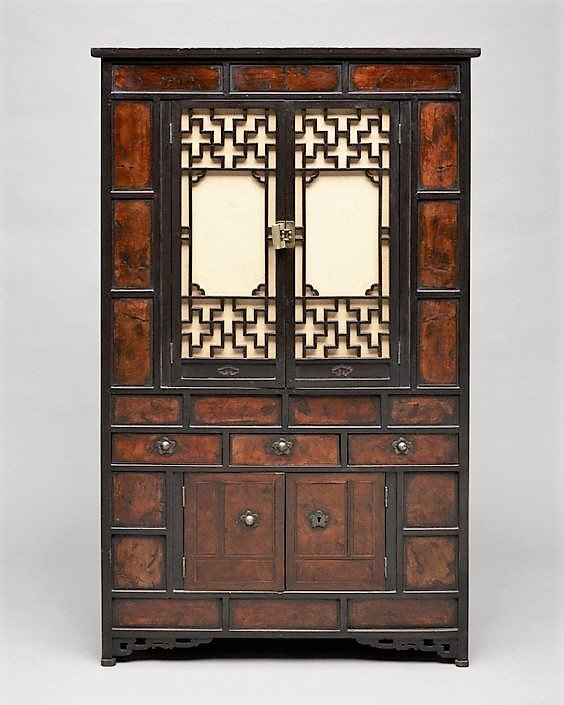
Large bookchest from the very late Joseon Dynasty. Pear & ash woods. Unusual design and weird doors fittings for a Korean Traditional piece of furniture.
Sold in an auction in Seoul, Korea.
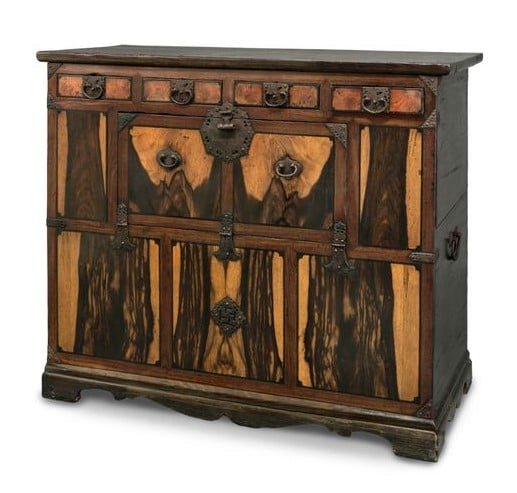
Persimmon wood, iron fittings.
H. 95cm, W. 111cm, D. 50cm.
K Auction, Seoul, Korea.
Four top drawers and a middle opening panel which doesn’t extend all the way.
This type of Bandaji was also used as a document chest amongst elites.
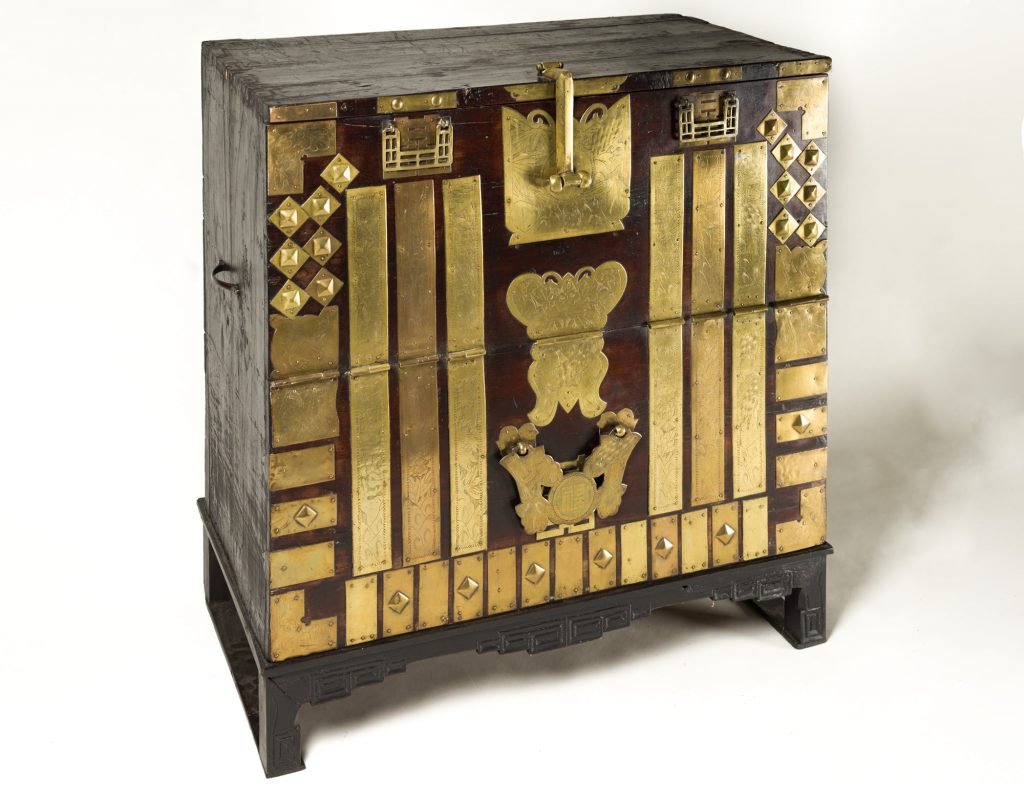

PYONGYANG BANDAJI
Elaborately decorated with ornate brass mounts in various geometric forms, some of which have incised landscapes and other imagery like pine and bamboo. The chest also has a butterfly shaped lock plate and is decorated all over with auspicious characters. Handles are on the side for carrying, and the chest sits on a stretcher with four short legs to create a handsome presentation.
The front folds down on hinges and opens to a large uninterrupted and lined interior.
H. 90.8cm, W. 87cm, D. 44.5cm. Collection “Naga Antiques”. USA
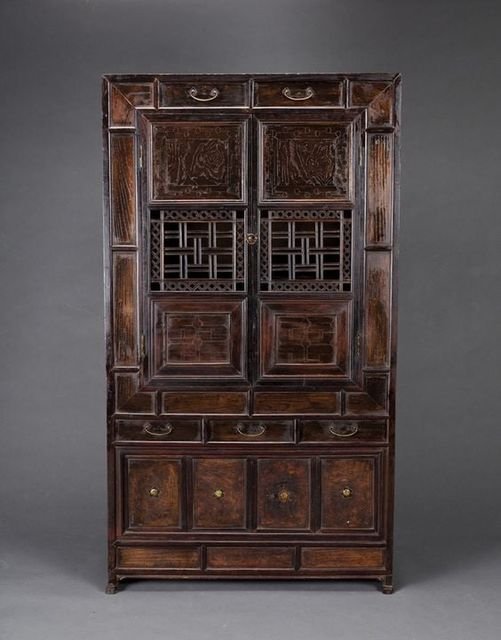
Auction House Koreanart 21, Seoul, Korea.
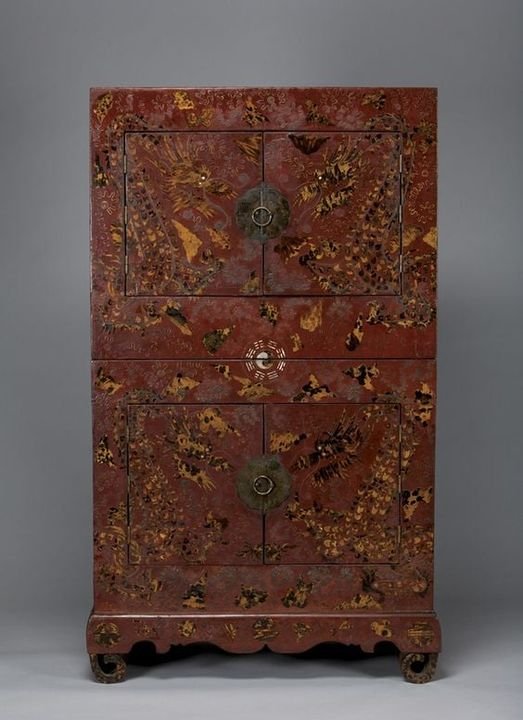
Red lacquered two level stacked chest with mother-of-pearl and tortoise shell inlay. Private collection.
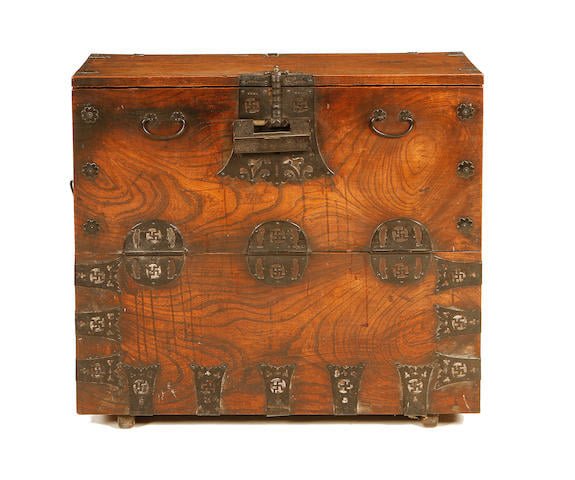
Korean 19th century elm wood bandaji. the drop front enclosing a fitted interior of five drawers and a shelf. W. 86cm, D. 43cm, H. 79cm. This piece was on display in an Auction (Bonhams, UK)
Wood grain is stunning and it bears very elaborate metalwork.
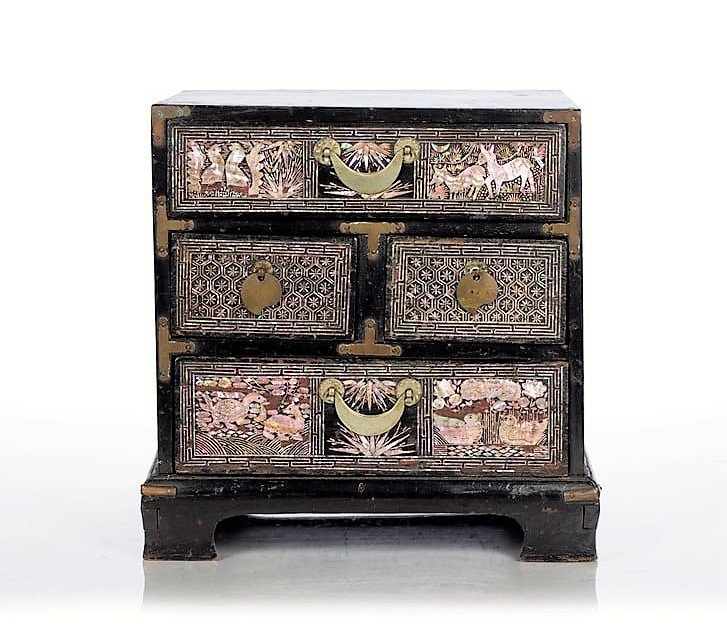
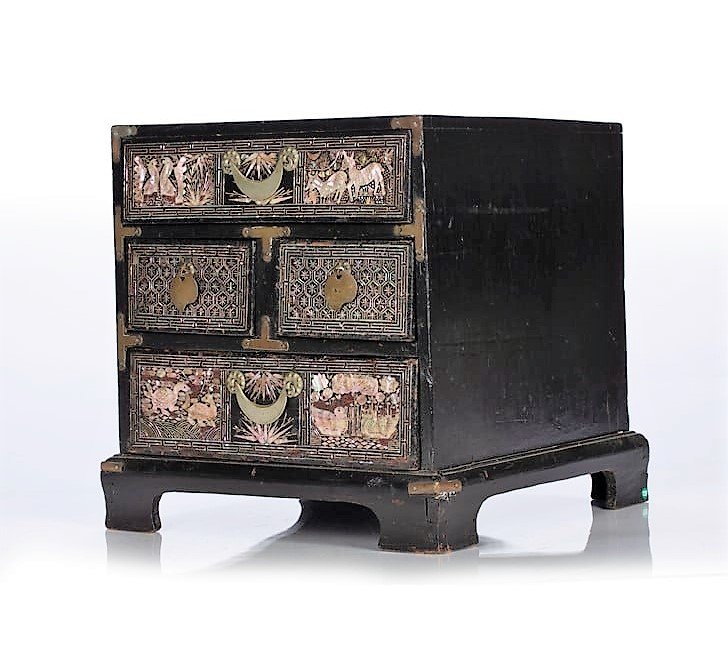
INCIDENTAL BOX.
Mother of pearl decorated cabinet.
Korean decorated to the front depicting various animals, with two long and two short draws, 28cm high x 26.5cm across. On Auction in Great Britain. 2021.
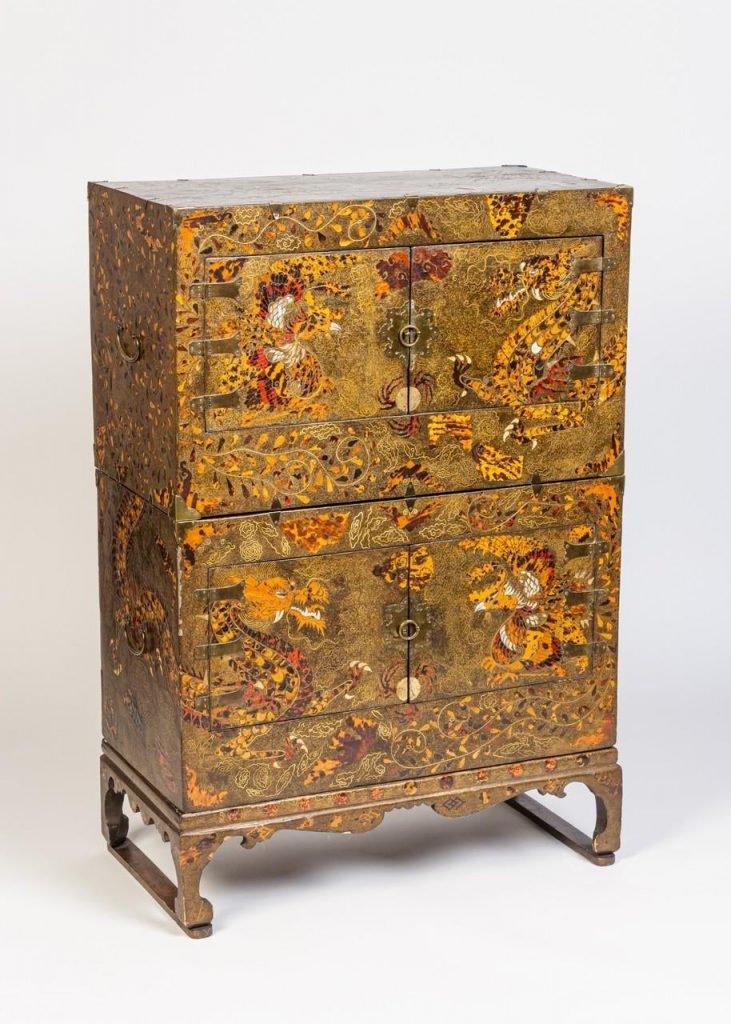
The two section lacquered chest on stand decorated with images of dragons and phoenix, inlaid with tortoiseshell, mother-of-pearl, and shagreen.
H. 116,8cm, W. 79,3cm, D. 40 cm.
Late 19th/early 20th c. On Auction in Canada.
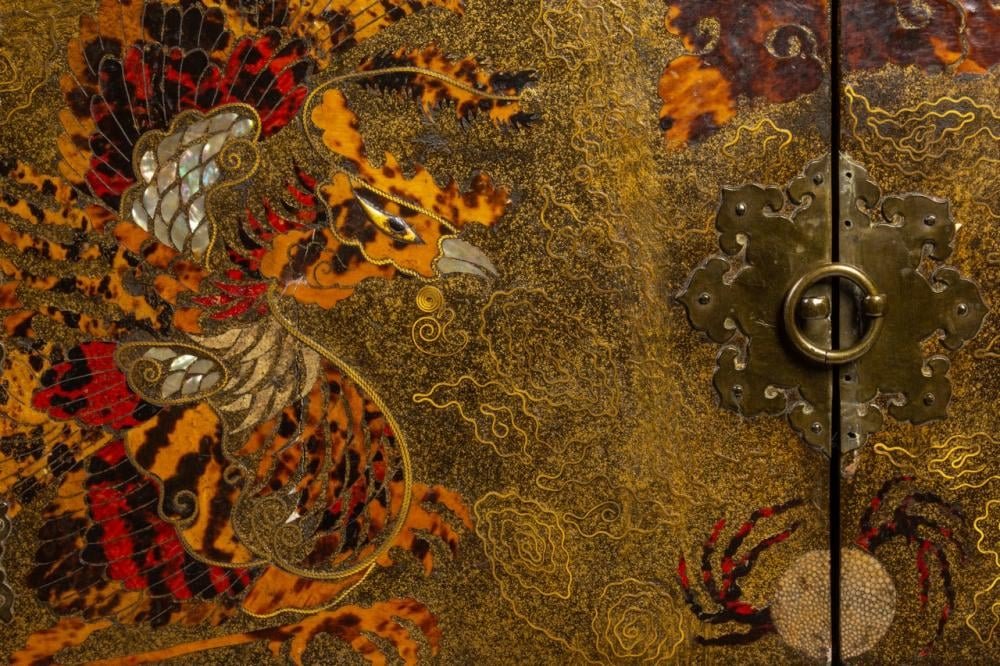
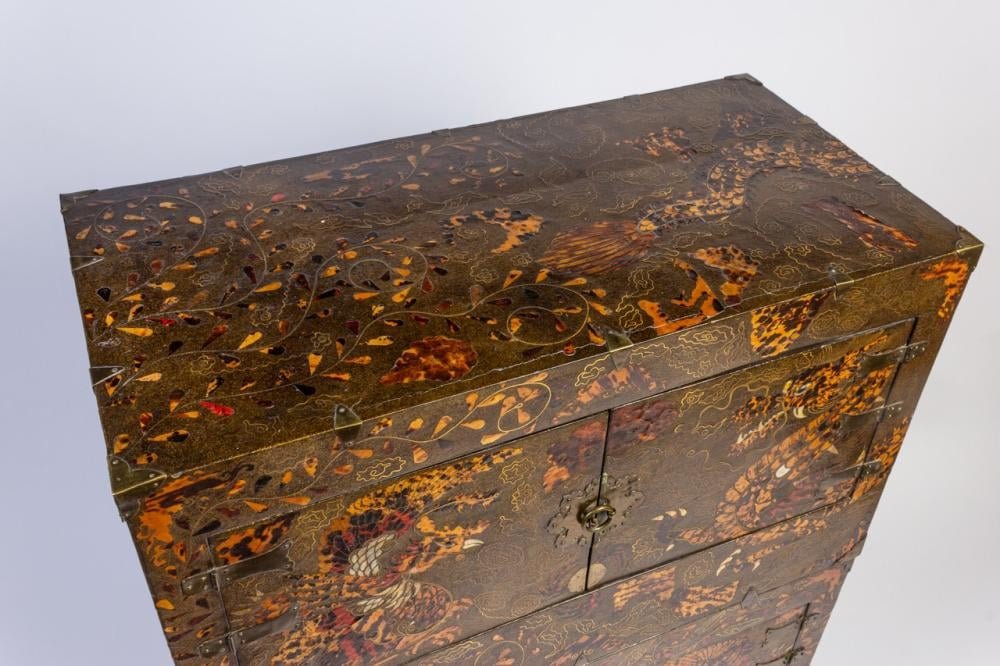
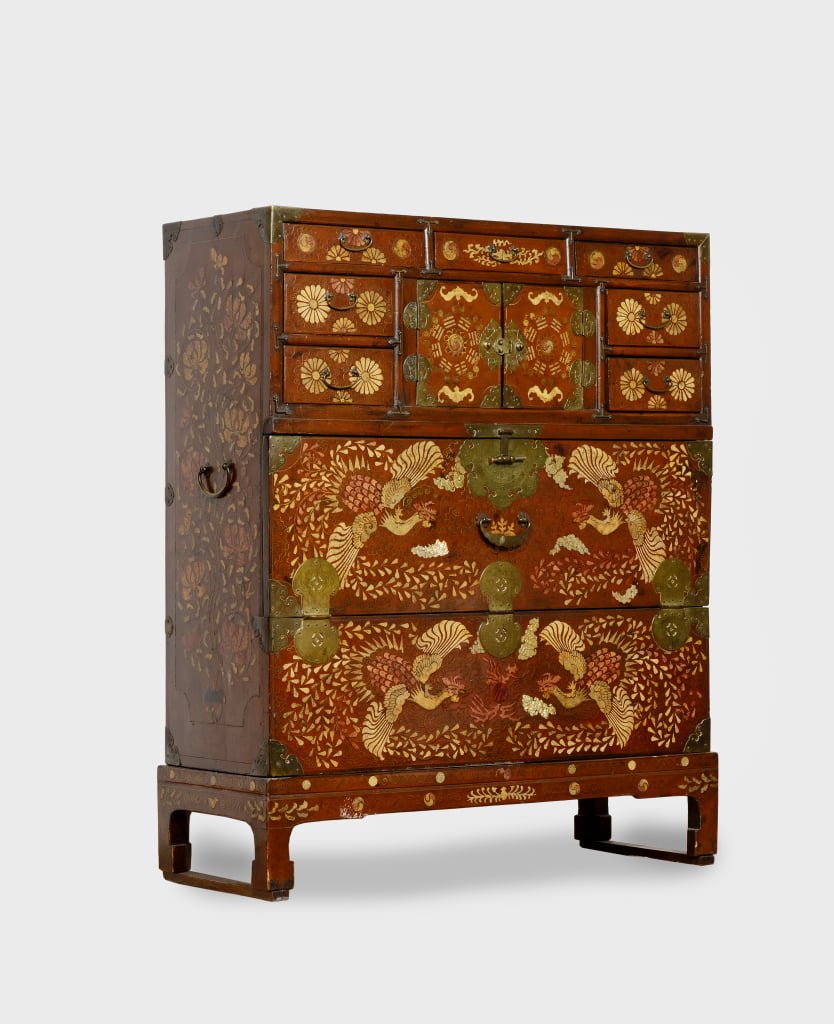
Early 20th century, wood with amber lacquer, inlaid with sharkskin, tortoise shell, mother-of-pearl, and gild copper wire; brass fittings. Collection of the Portland Museum, USA.

Antique Korean Bandaji storage chest featuring drop-front drawer with large stylized swallowtail lock and two small drawers to either side. Yellow brass hardware showing incised and openwork designs, including auspicious symbols and bats. 19th Century.
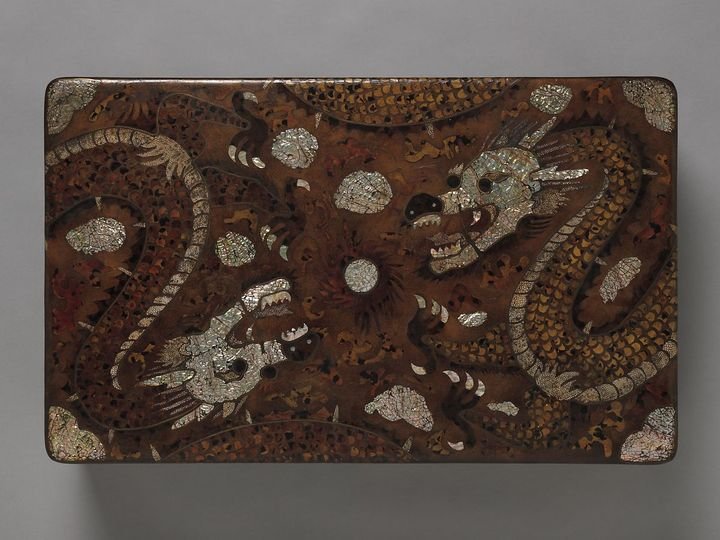
Clothing box decorated with dragons
19th century. Korea.
Lacquer inlaid with mother-of-pearl, tortoiseshell, and ray skin.
Metropolitan Museum (The Met), New York, USA.
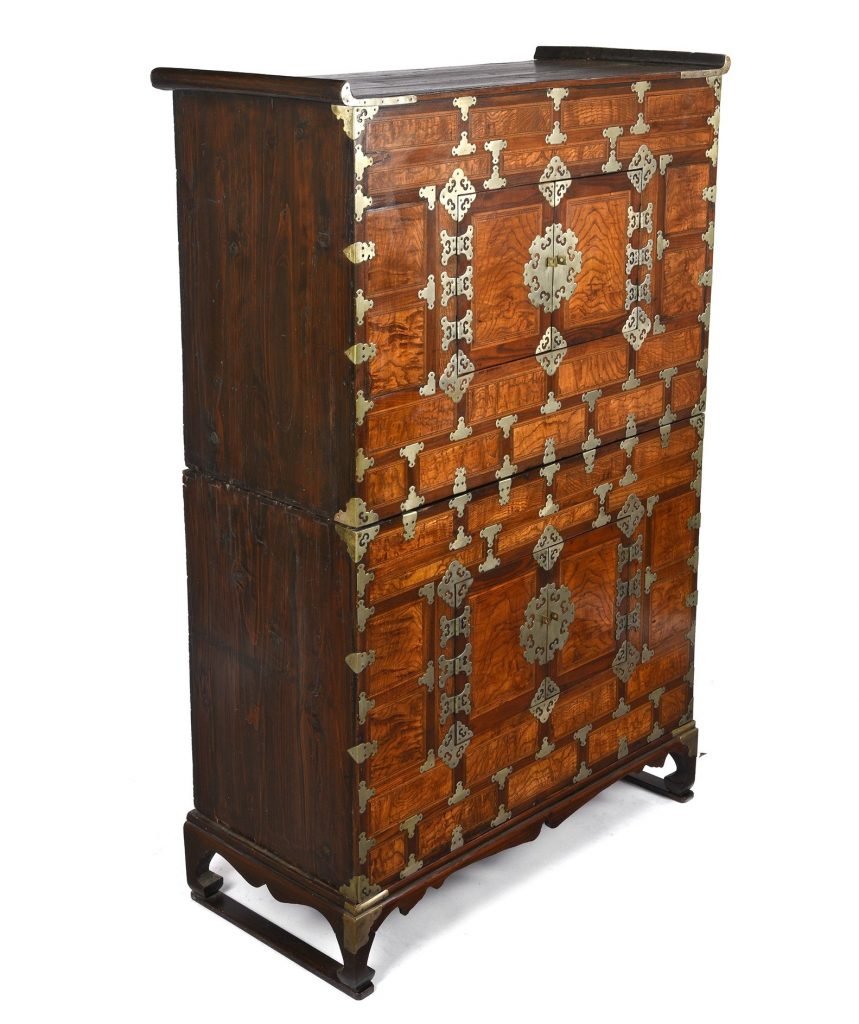

TWO LEVEL CHEST – ICH’UNG NONG
Elm wood and roots, pine. White brass fittings. Late 19th to early 20th century.
H. 142,5cm, W. 91,5cm, D. 43cm. Fittings design seems to indicate that this piece is coming from the southern part of the peninsula in (Masan area) Gyeongsang Do province.
Photo credit: INDIGO ANTIQUES. www.indigo-uk.com.
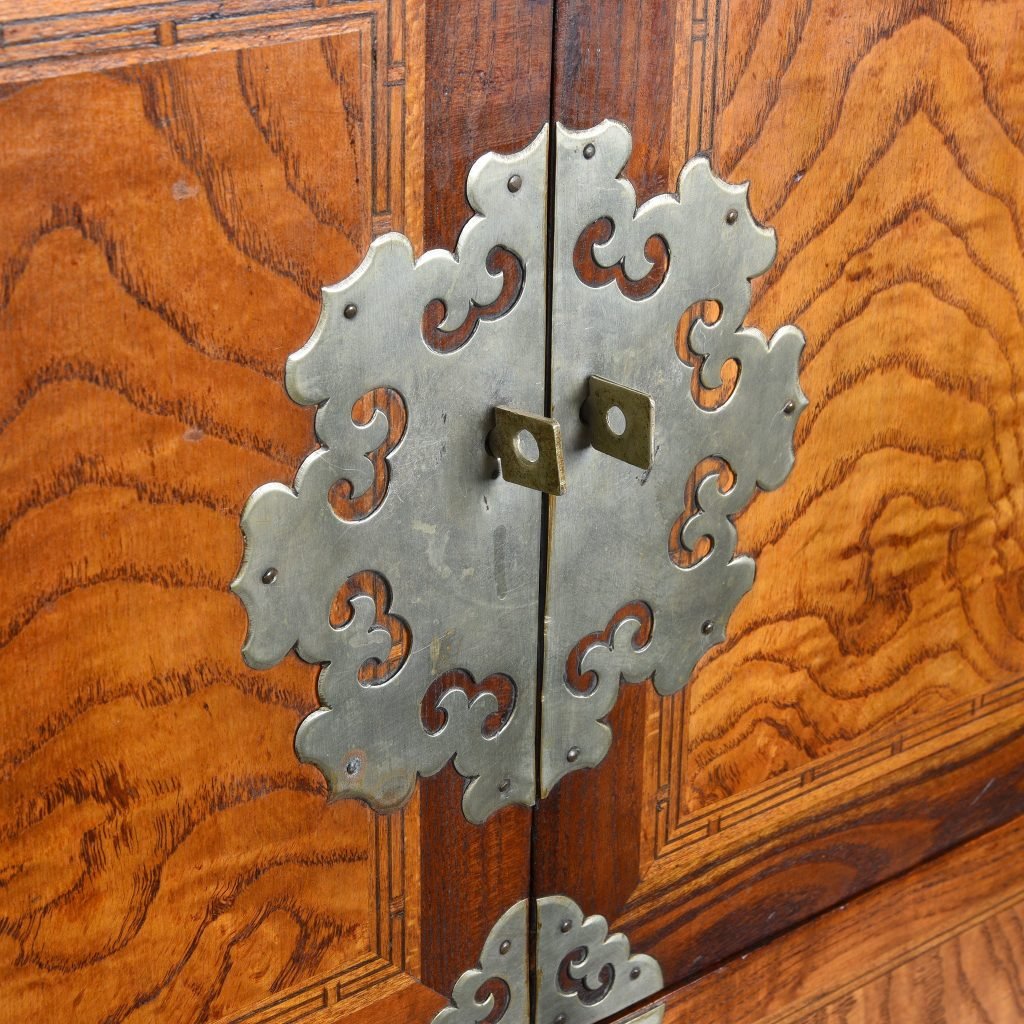
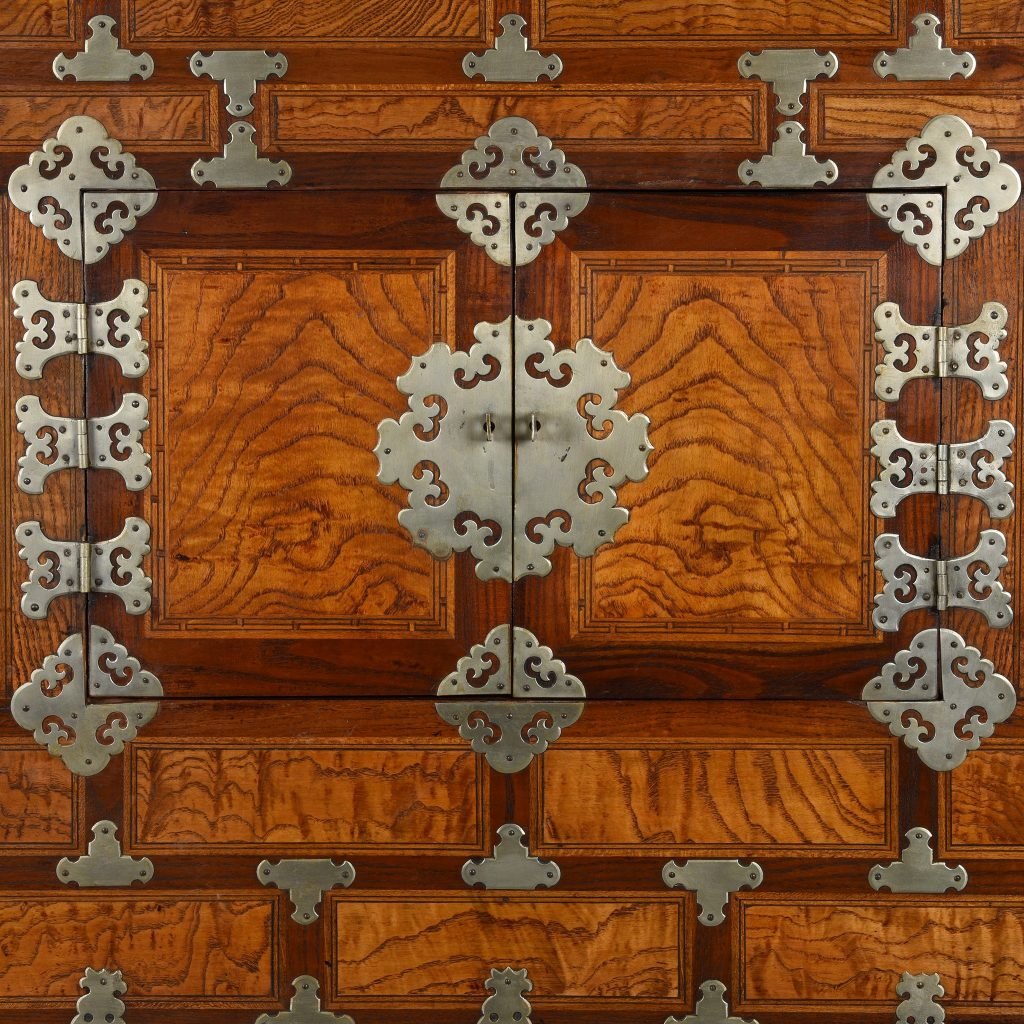

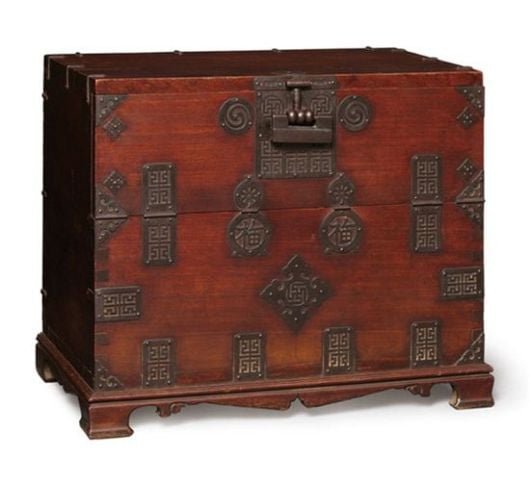
Pine wood, iron fittings, oil finish.
H. 59cm, W. 74cm, D. 42cm. Late Joseon Dynasty, probably late 19th century.
Ganghwa area.
This type of chest was rarely made in small size and was used to store clothes, books, scrolls, etc. Very intricate iron metalwork. A fine piece.
This piece was presented in an auction in Seoul, Korea in 2011. Estimate price was KRW. 80,000,000 – 120,000,000.-
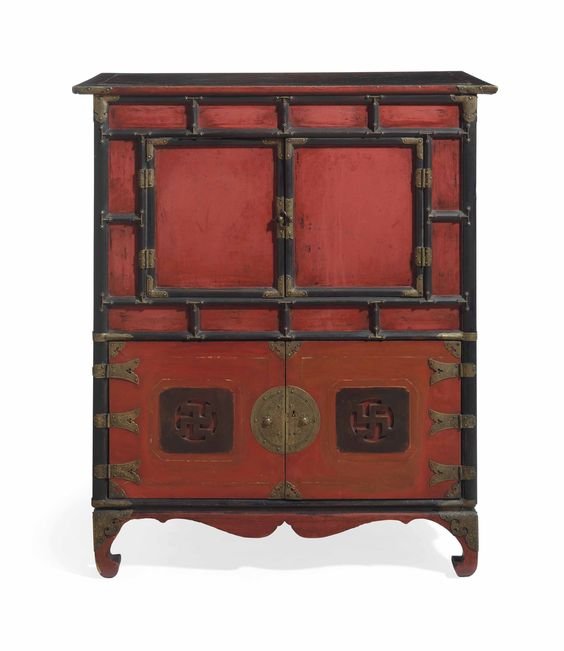
Paint on wood. H. 77,4cm W. 69,8cm, D. 41,9cm.
20th century.
Sold by Christie’s in 2018.
Estimate: $ 2,500 – 3,500.-
Price realized: $ 20,000.-
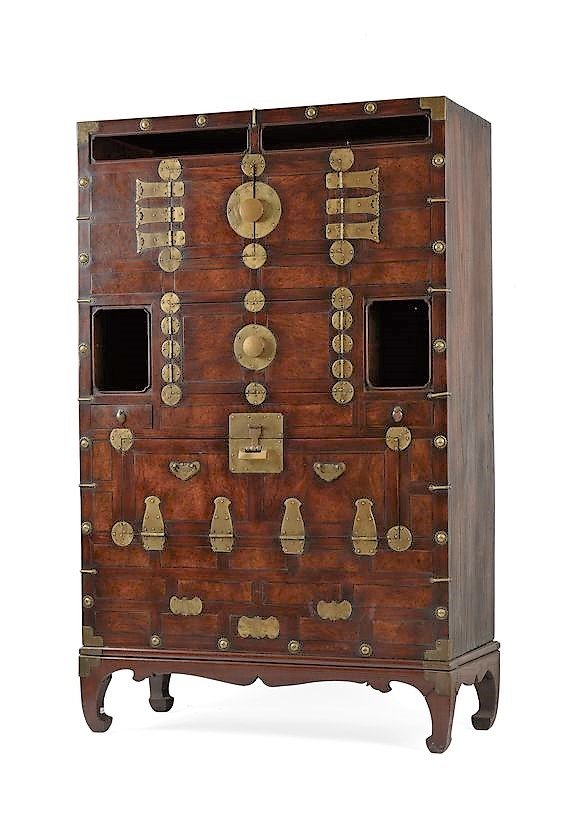
The design is unique with its small opening sections. Nice wood and typical metalwork design from the Gyeonggi Do province. Was probably used as a book chest to store books and documents and display some artifacts.
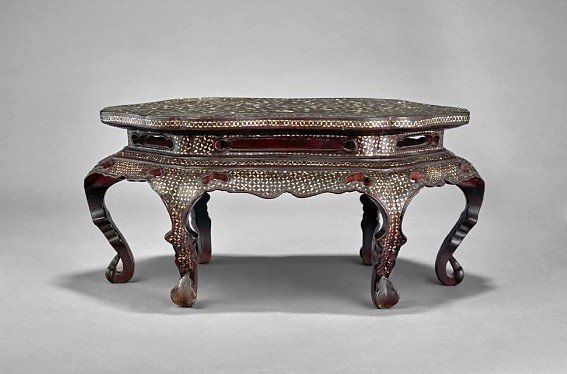
JOSEON DYNASTY (17TH-18TH CENTURY)
The hexafoil table set on six cabriole legs, finely decorated in inlaid mother-of-pearl with geometric patterns and floral scrolls of chrysanthemum on black lacquer ground, applied with red lacquer on the interior
16 3⁄4 x 10 3⁄8 x 8 1⁄8 in. (42.5 x 26.4 x 20.6 cm.). Courtesy of Christie’s New York.
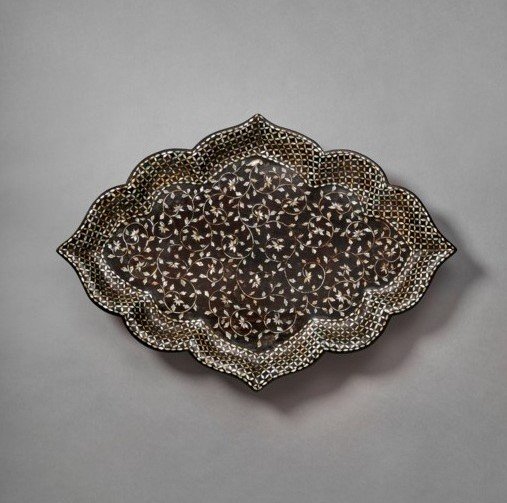
JOSEON DYNASTY (16TH CENTURY)
Inlaid on the interior and exterior in mother-of-pearl with lotus arabesques and circular geometric pattern on a black ground, the foliate-shaped foot rim enclosing the base of red lacquer
17 3⁄8 in. (44.1 cm.) long. Photo courtesy of Christie’s New York.
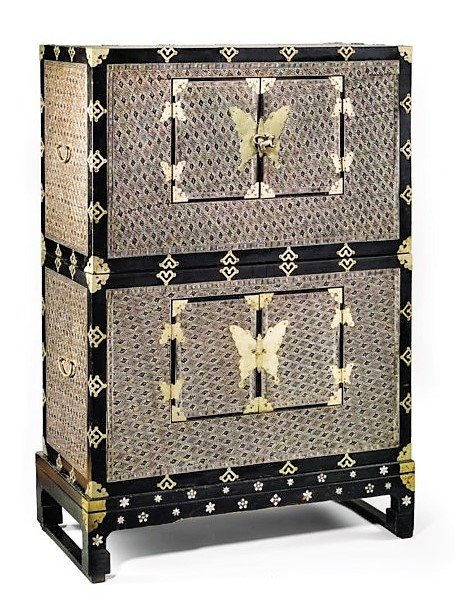
KOREA, JOSEON DYNASTY, 19TH-20TH CENTURY
It consists of two rectangular chests one on top of the other resting on a four-legged base. Each chest opens to two doors in front. It is decorated with a geometric decoration of mother-of-pearl inlays and punctuated with gilded metal fittings in the form of butterflies around the leaves. The back is decorated with a mother-of-pearl inlay of bamboo and plum blossoms.
Dimensions: 116 x 79 x 39 cm. (45 ¾ x 31 1/8 x 15 3/8 in.)
Sold at Christie’s Paris, December 2020. Estimate: Euros: 6,000 – 8,000.- SOLD for Euros: 32,500.-
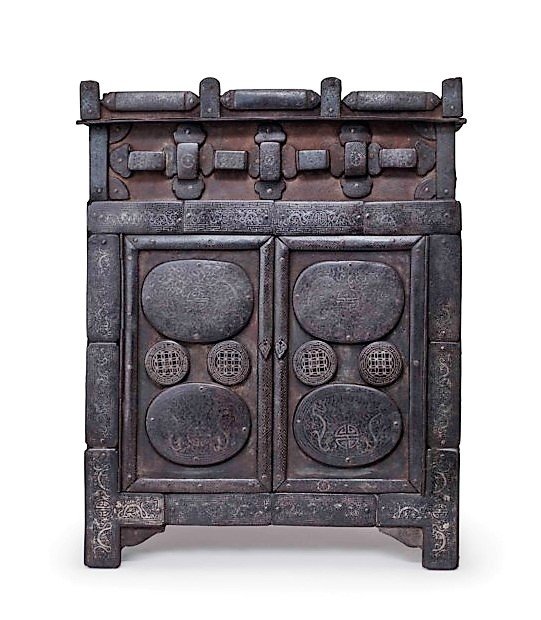
An iron cabinet with a pair of hinged doors, elaborately decorated in inlaid silver bands of dragons, bats, and longevity medallions
5 ¼ x 11 7/8 x 15 3/8 in. (13.3 x 30.2 x 39 cm.)
Joseon Dynasty ( 19th century)
Price realized USD: 8,125
Estimate: USD 4,000 – USD 6,000
Christie’s Auction, Lot 110, April 25th, 2017.

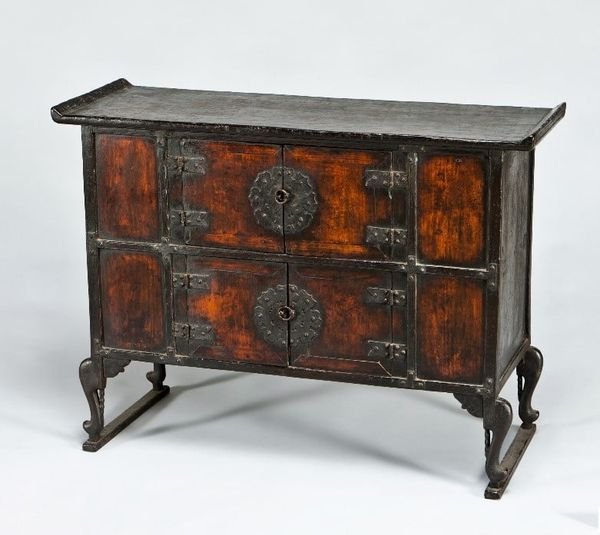
Height 71.0cm, Width 96.5cm, Width 34.8cm
Collection of the Korean National Museum. Seoul, Korea.
Original book chests are hard to find nowadays because they were produced in small quantities for an affluent class of the population. Small in size, the front part of this piece of furniture consisted of doors with sometimes a row of drawers on the upper part. The ends of the top panel could be lifted up so that the rolls placed on it would not fall off. They were also shallow (around 35cm) and raised on elegantly decorated legs.
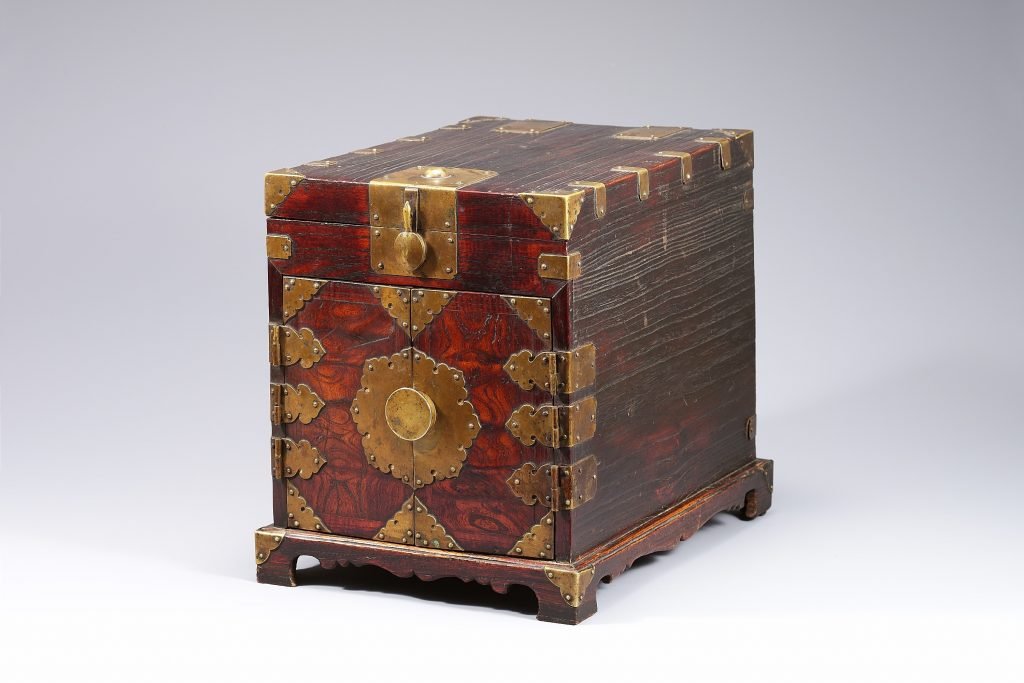
H. 29,7cm, W. 23,4cm, D. 32.5cm.
This beautiful box called “Pit-Chop” in Korean was used in the woman’s quarter to store small accessories such as combs, brushes, and cosmetic powder.
Beautiful woods have been used such as fine-grained zelkova on the front part enhanced by quality yellow brass fittings. Paulownia wood sides and top. This box stands on elegant legs. Origin: Probably Gyeonggi Do Province. Korea.
Collection of the National Museum of Korea.
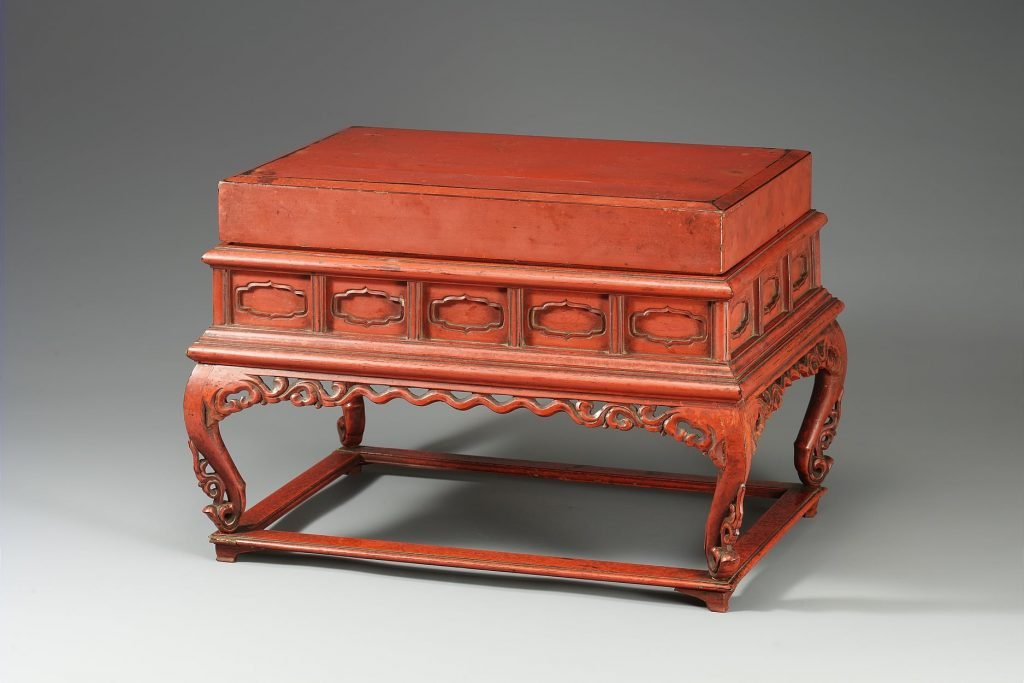
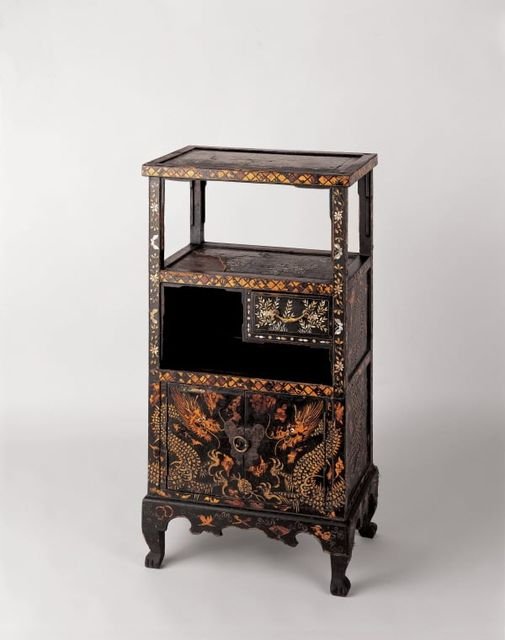
H. 91cm, W. 48cm.
Fine linen-covered pine wood and black lacquer was applied to it.
In the lower part of the front, a scene where two dragons fight over a cloudy sky, and grass and insect patterns are decorated in a balanced way between them.
Other parts were decorated with grass and insect patterns on black lacquer with mother-of-pearl inlay.
Given its elegance, it is presumed that this chest was used by the royal court. Collection of the Gyeonggi Provincial Museum.
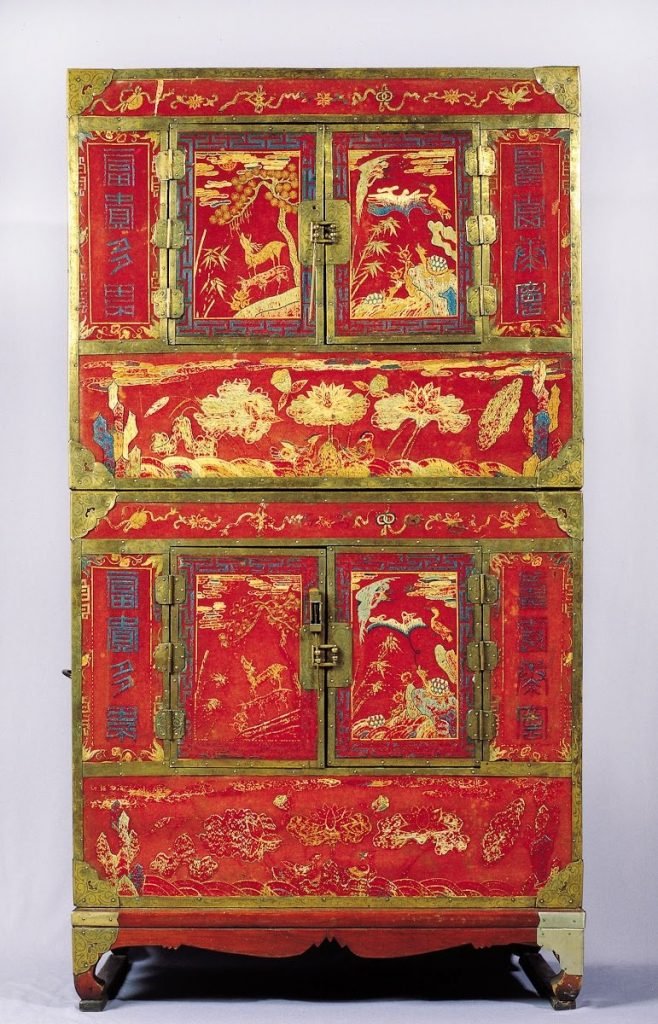
This embroidered chest is said to have been produced for the garye (wedding) of queen Sunwon, who was the wife of Sunjo, the 23rd king of the Joseon dynasty. The ten traditional symbols of longevity were embroidered on the door and on the lower part of the door, lotus flower and mandarin duck designs were embroidered so as to wish for the couple to be happy and bear many children.
Collection: Sookmyung Women’s University Museum, Seoul. Korea.
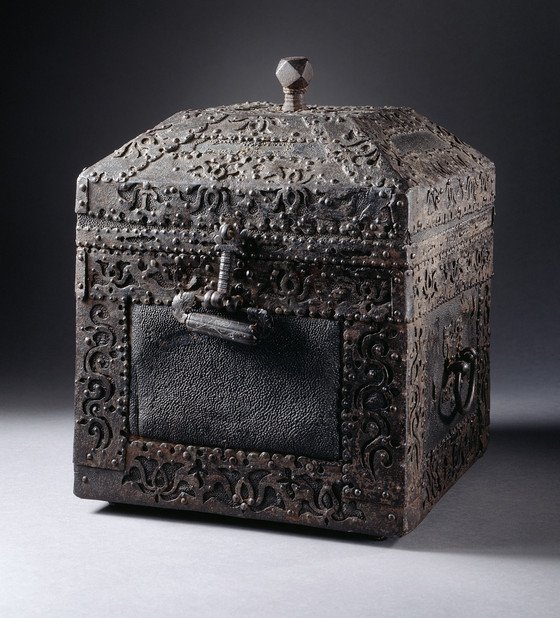
Korea, Joseon dynasty (1392-1910), 19th century.
Shark skin on wood core with hammered, cut, and cast iron fittings with silver wire inlay
15 x 11 x 11 in. (38.1 x 27.94 x 27.94 cm). Collection the LACMA Museum. USA
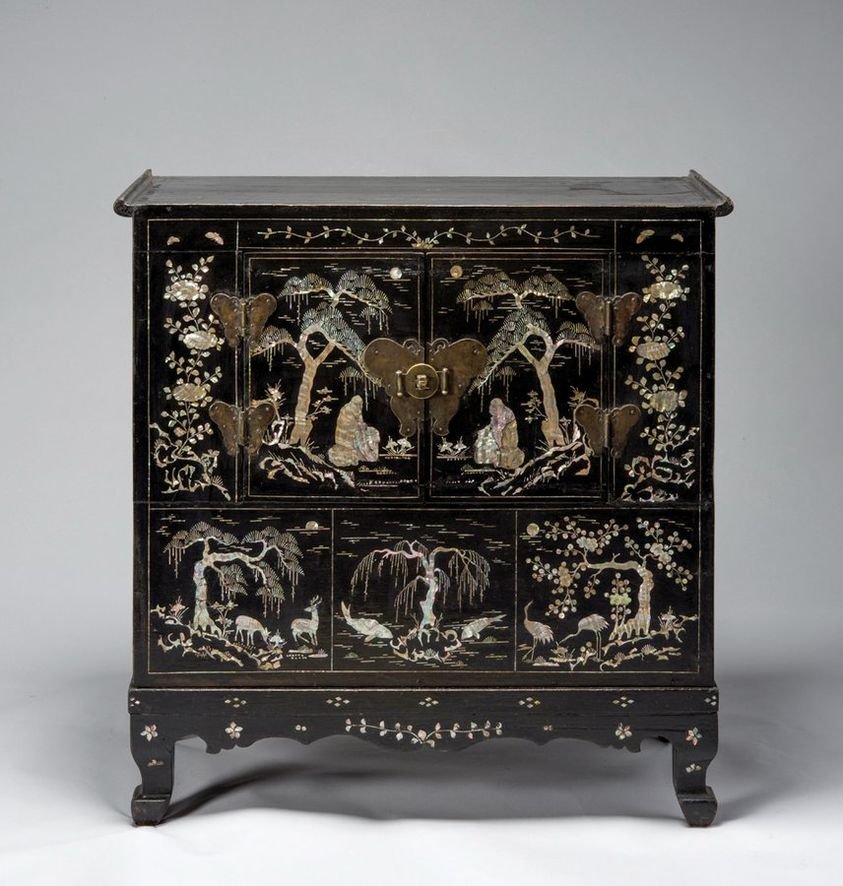
Black lacquer on wood, mother-of-pearl inlay. 19th century.
88.7×87.2.x41.5cm.
Korean art 21 Auction, Seoul.
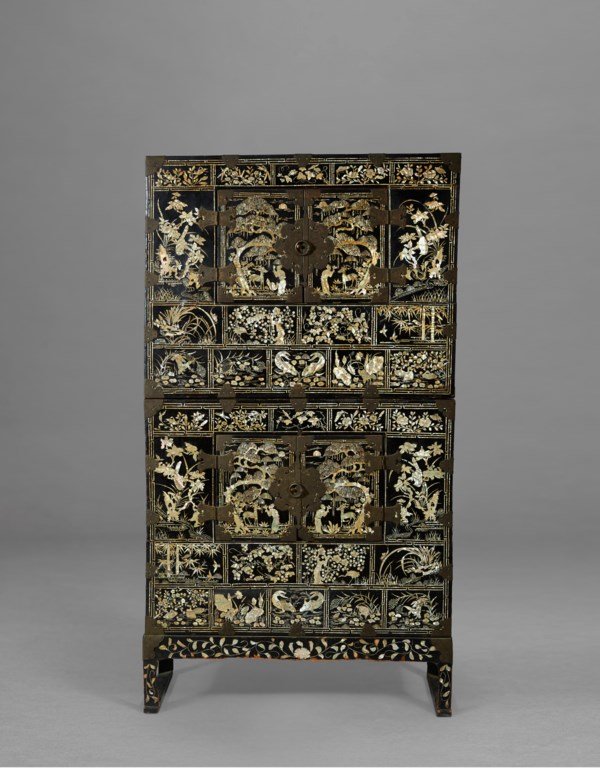
Joseon Dynasty (19th – 20th century).
H. 134cm, W. 74,6cm, D. 33,3cm.
Christie’s Auction. September 27th 2022.
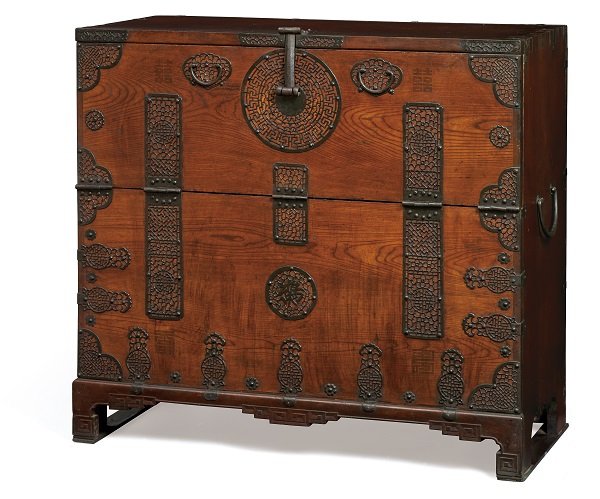
From Pyongan Do province, now days located in North Korea,. Very fine example of craftmanship with a nice selection of fine grained wood, very intricate handmade metal work and elegant base. Bukchon Museum. Cheongnam Building B1, 4 Bukchon-ro 7-gil, Jongno-gu, Seoul. Korea.
Not sure is on view.
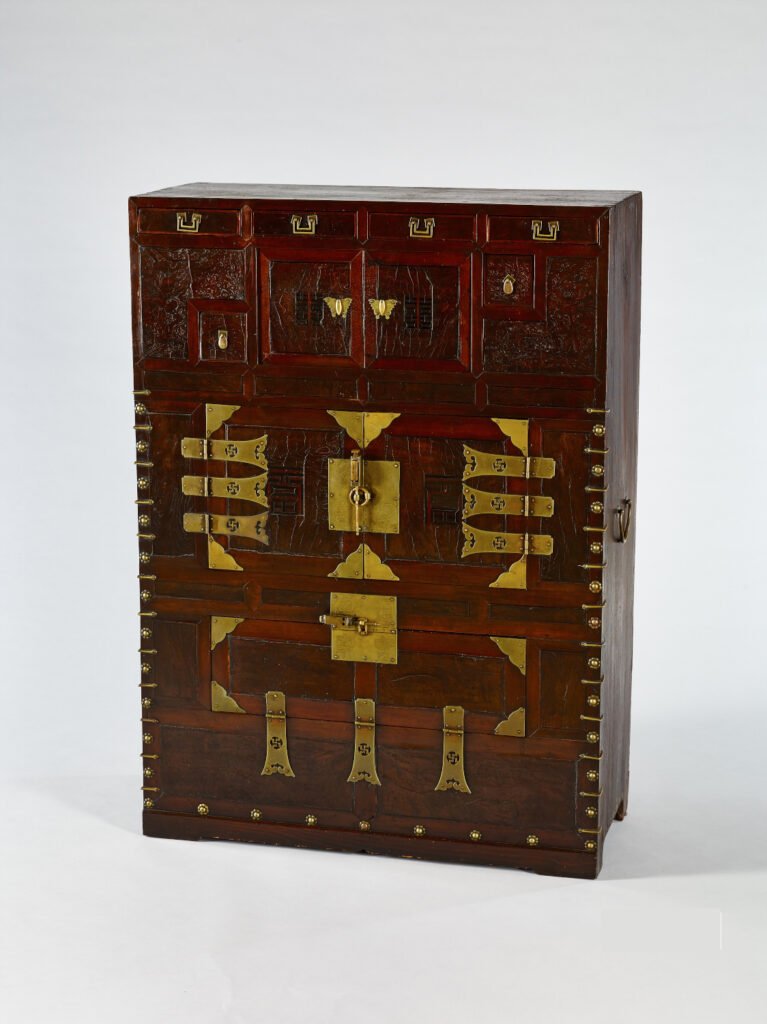
H. 121,5cm, W. 88cm, D. 39cm.
Also called a Jeongju wardrobe, this chest is from Jeongju city, capital of North Jeolla province
Collection: National Museum of Korea.
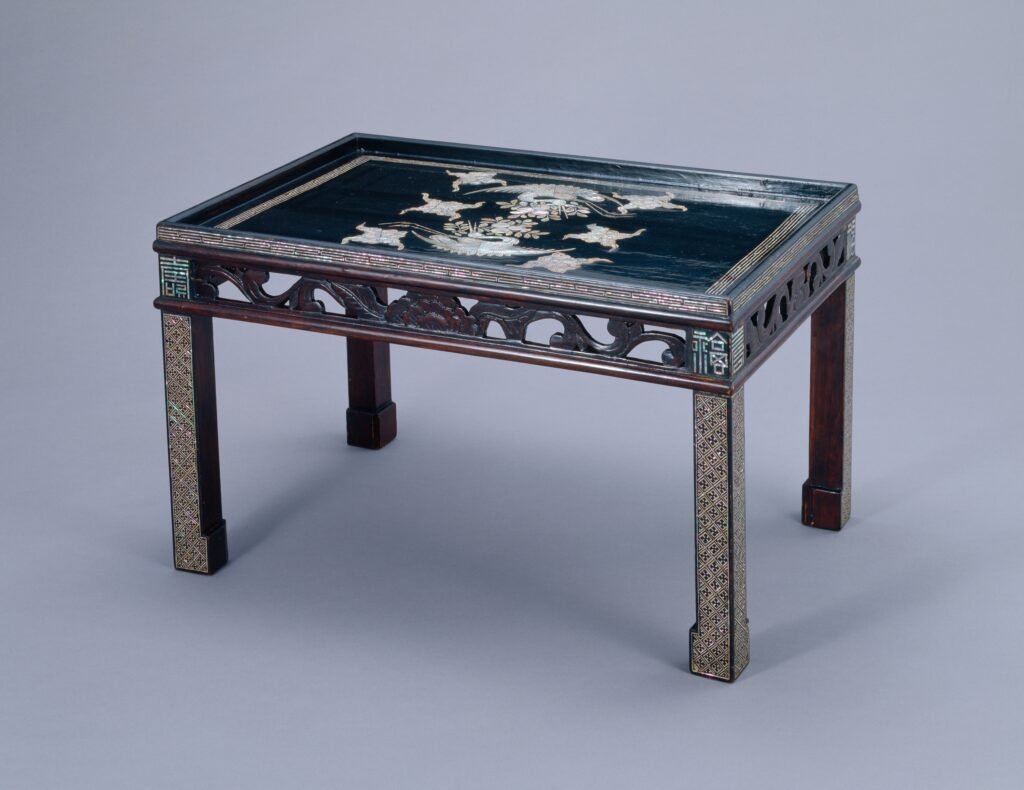
Late Joseon dynasty, 19th century. Collection: National Museum of Korea.
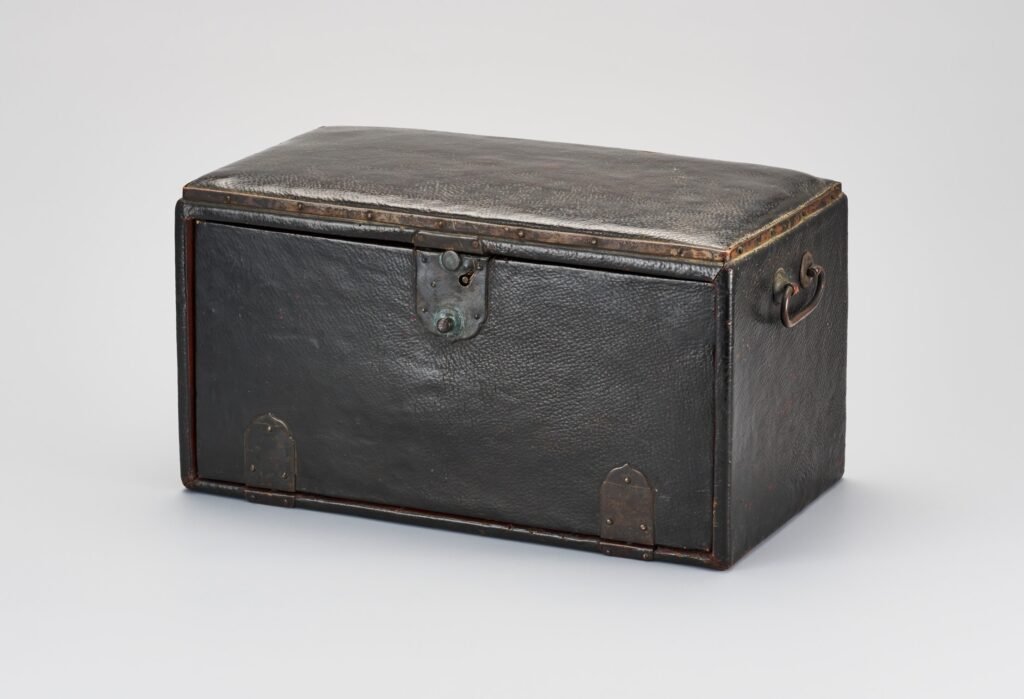
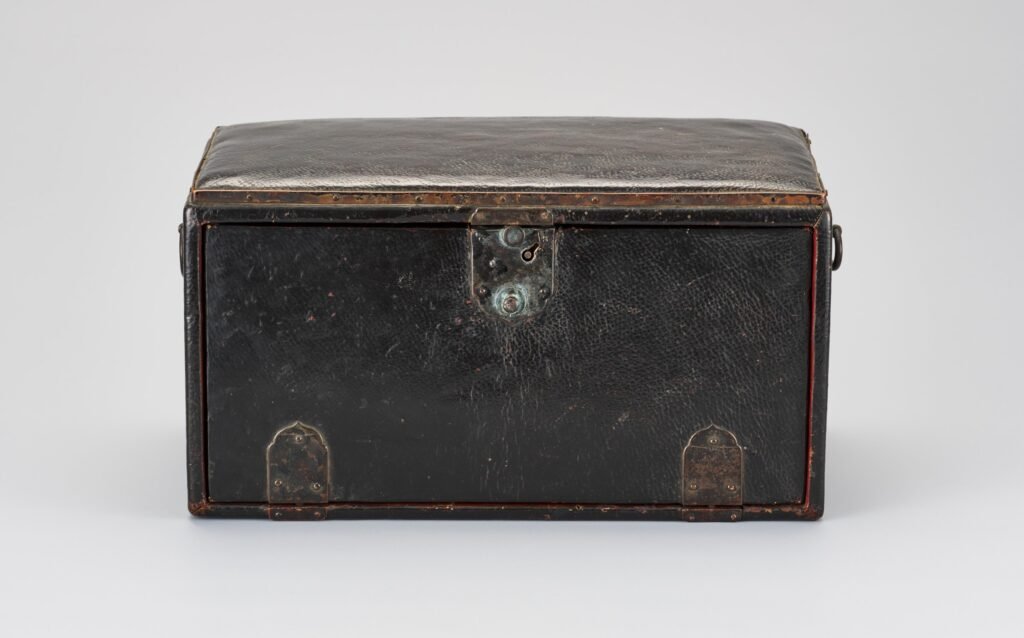

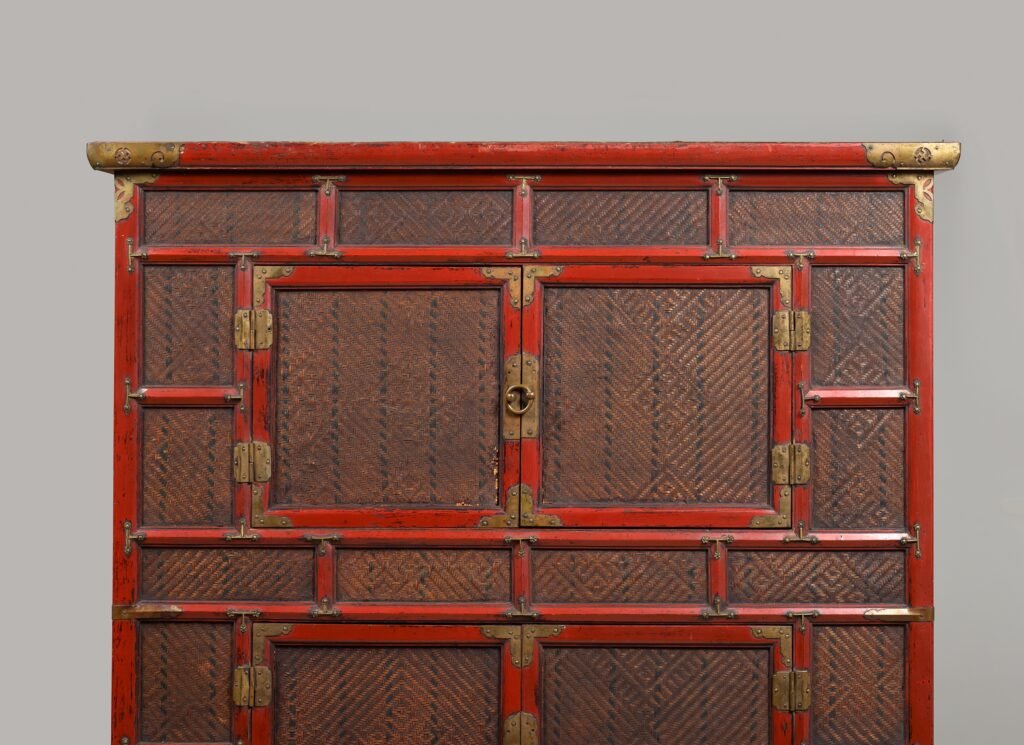
A large part of the front is covered with rattan.
Yellow brass fittings.
H. 180,5cm, W. 108,3cm, D. 62,3cm.
Collection of the national Museum of Korea.
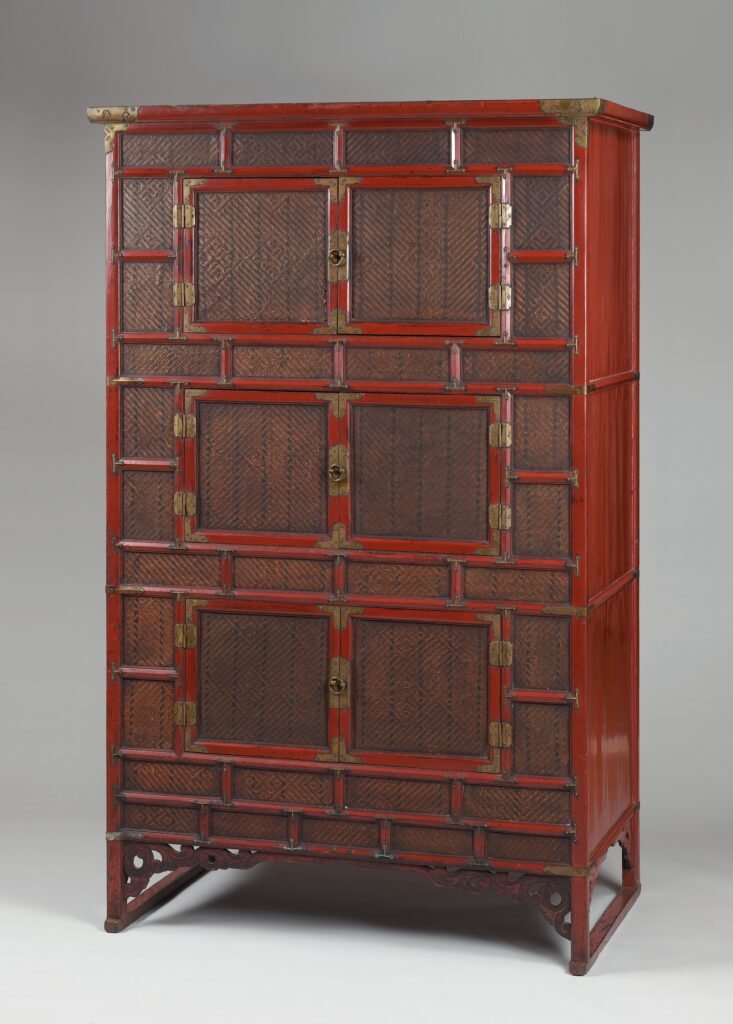
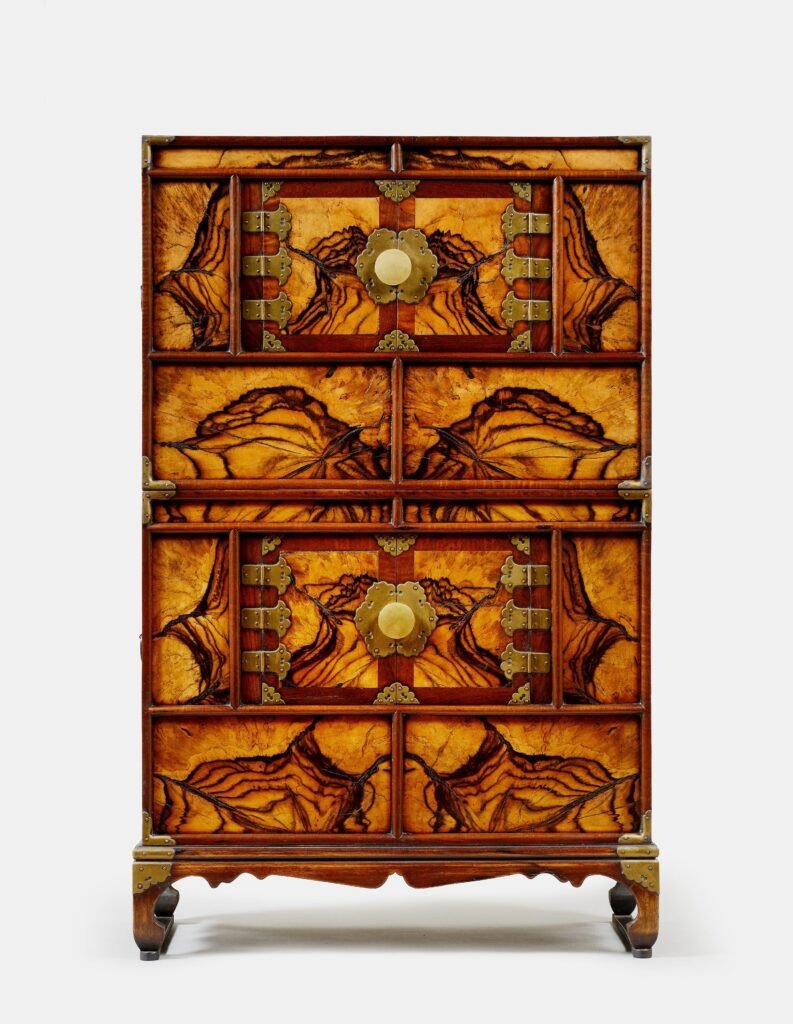
Persimmon wood. Yellow brass fittings.
Late 19th c to early 20th century.
Height 128cm, length 79,3cm, width 41cm.
Collection: Daegu University Central Museum. Korea.
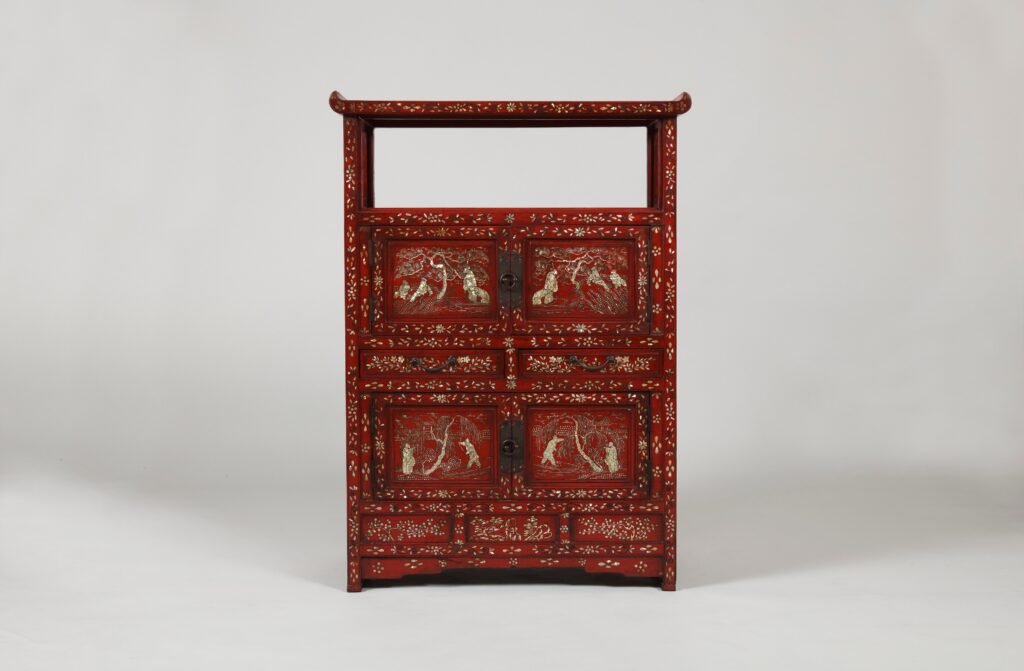
The upper section has raised ends and is decorated with a large rock with flowering trees and pines in the center.
Two small drawers were placed between the first and second levels.
The interior was finished with purple-tinted paper.
Dimension: H. 102,8cm, W. 73cm, D. 34,7cm.
Collection: Busan Metropolitan City Museum
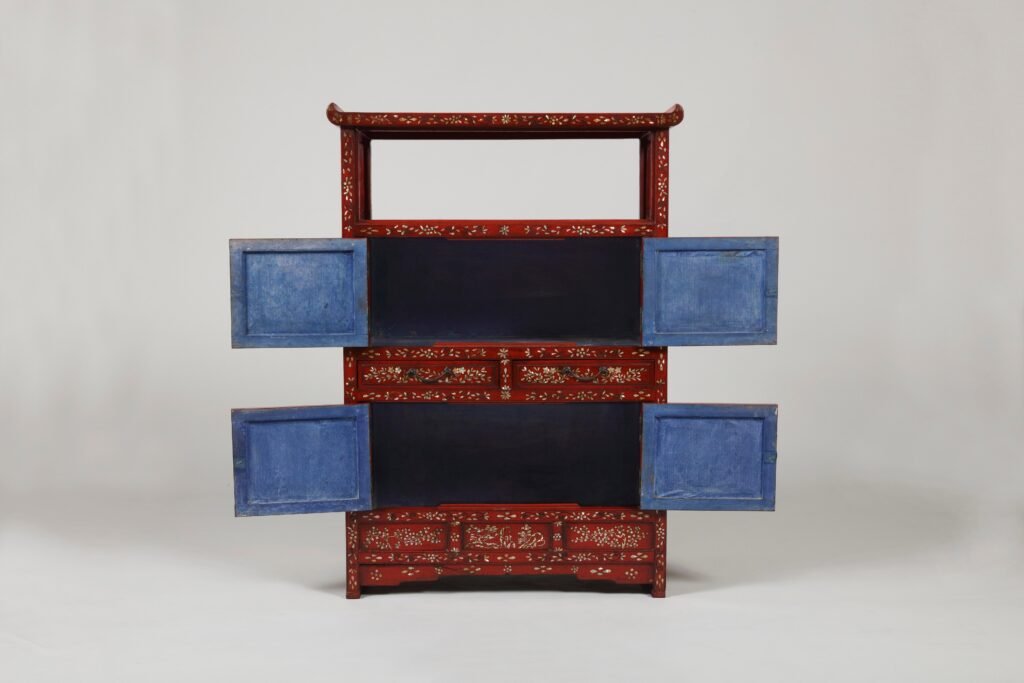
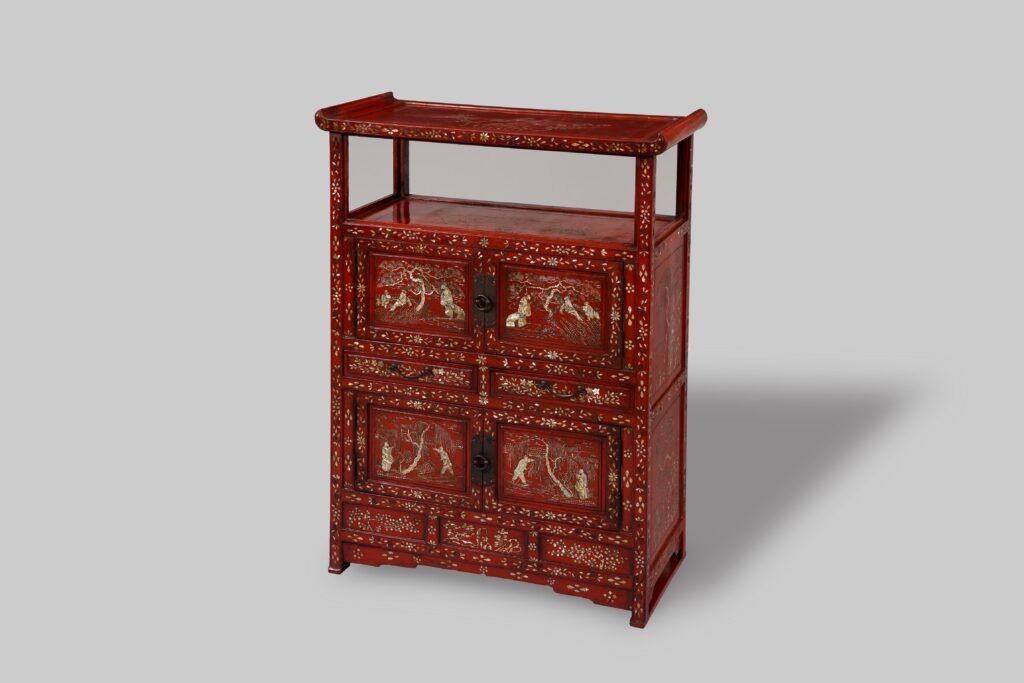
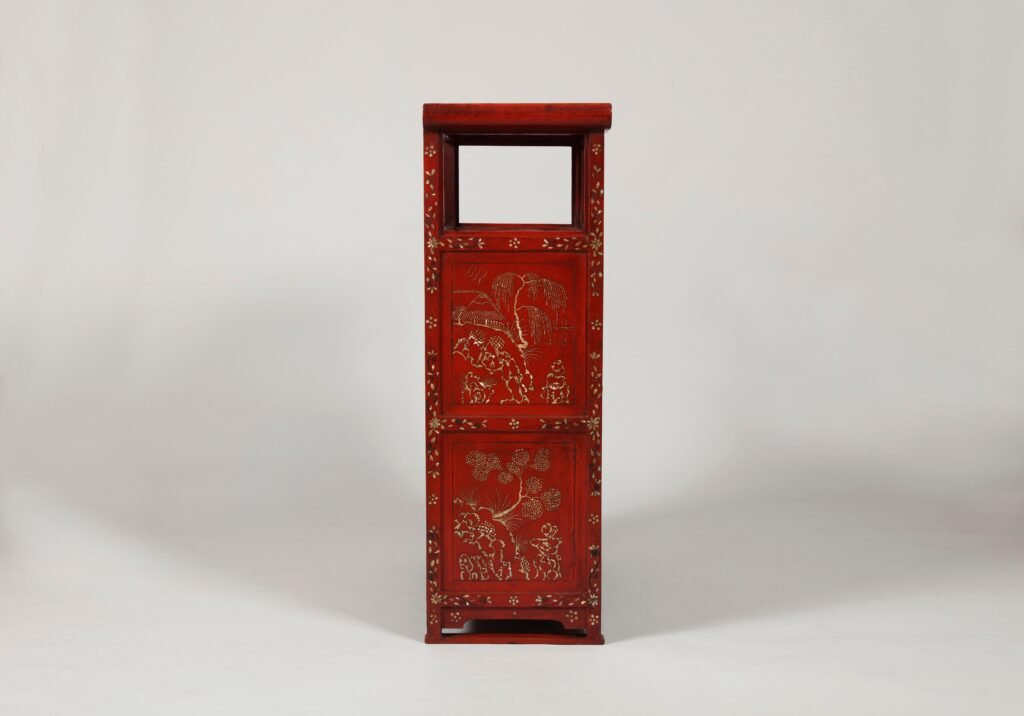
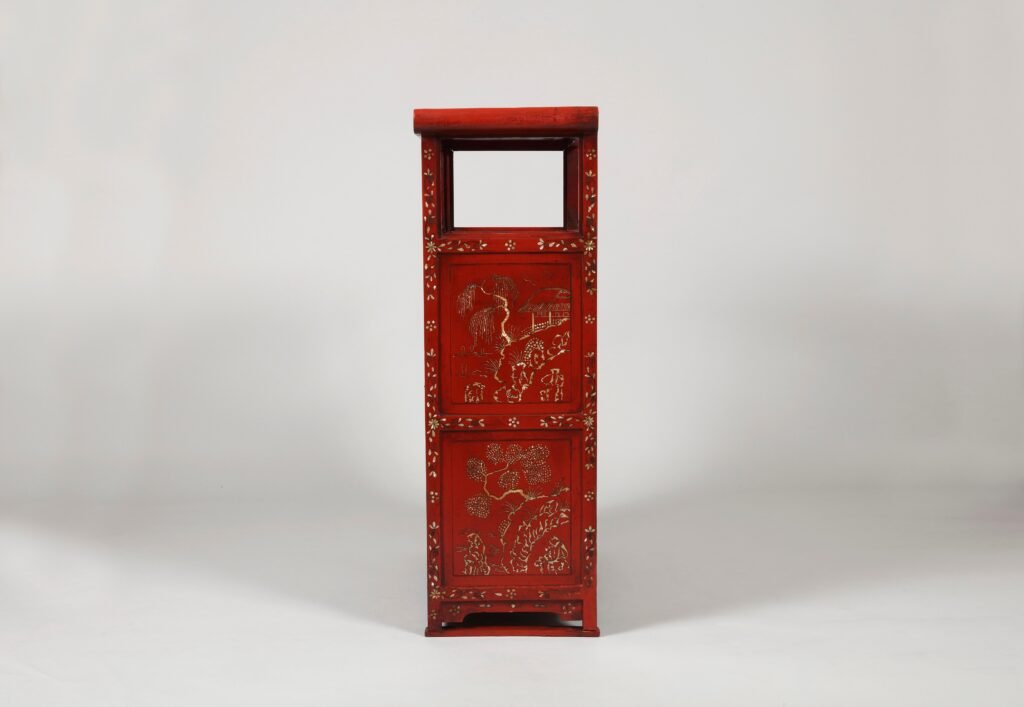
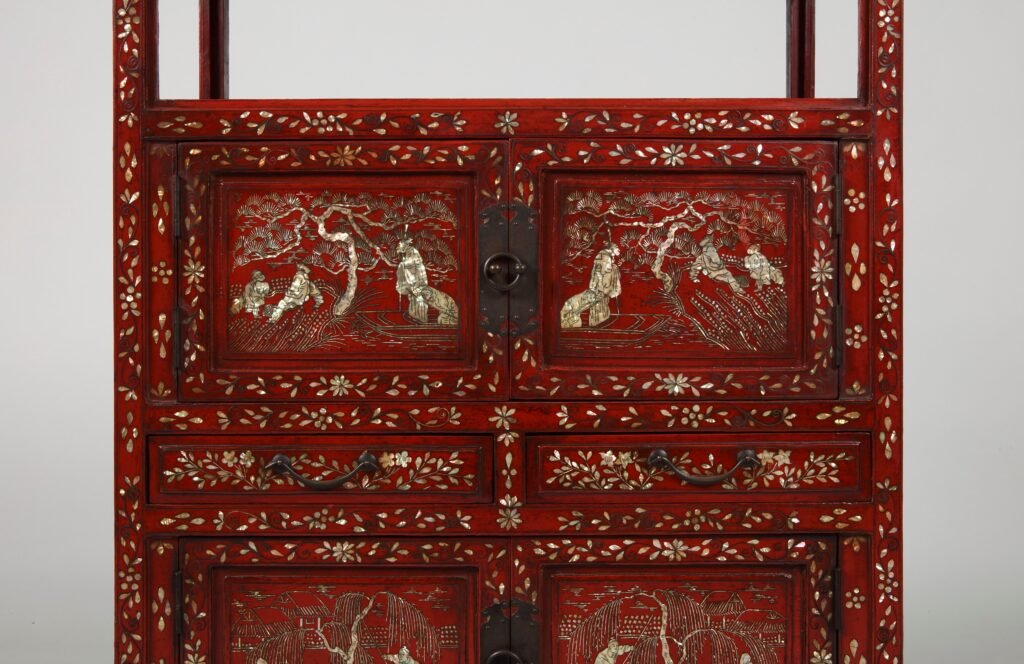
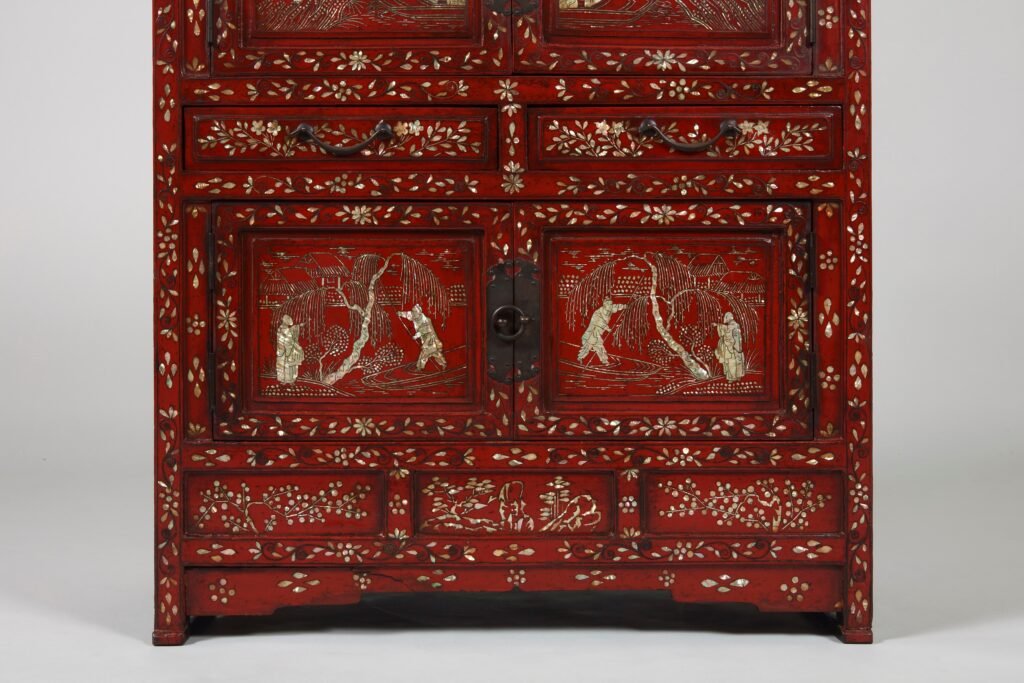
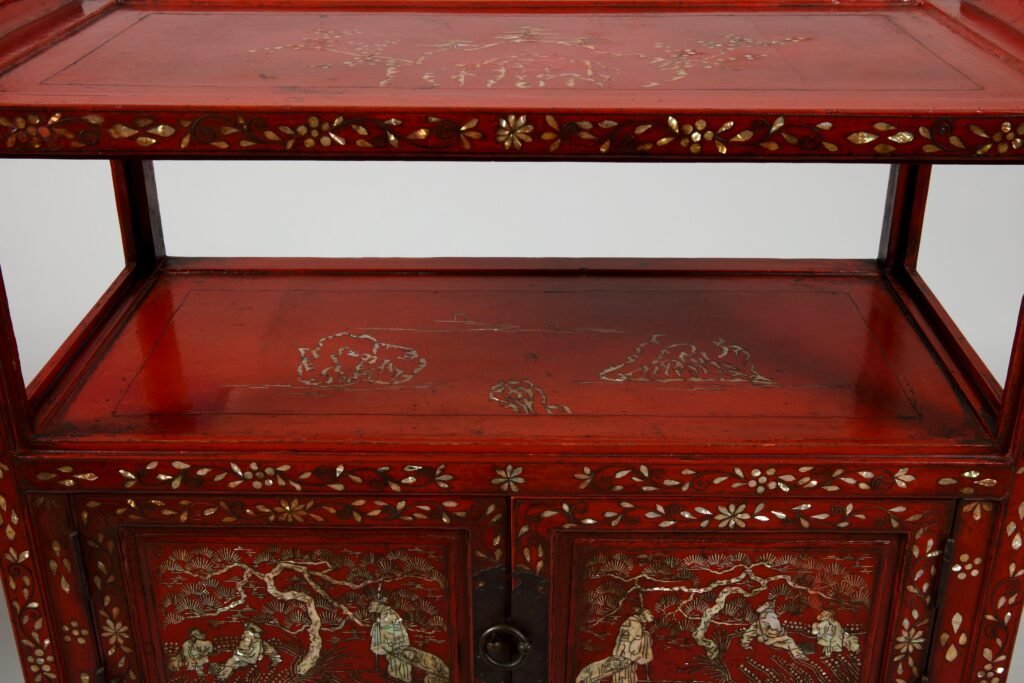
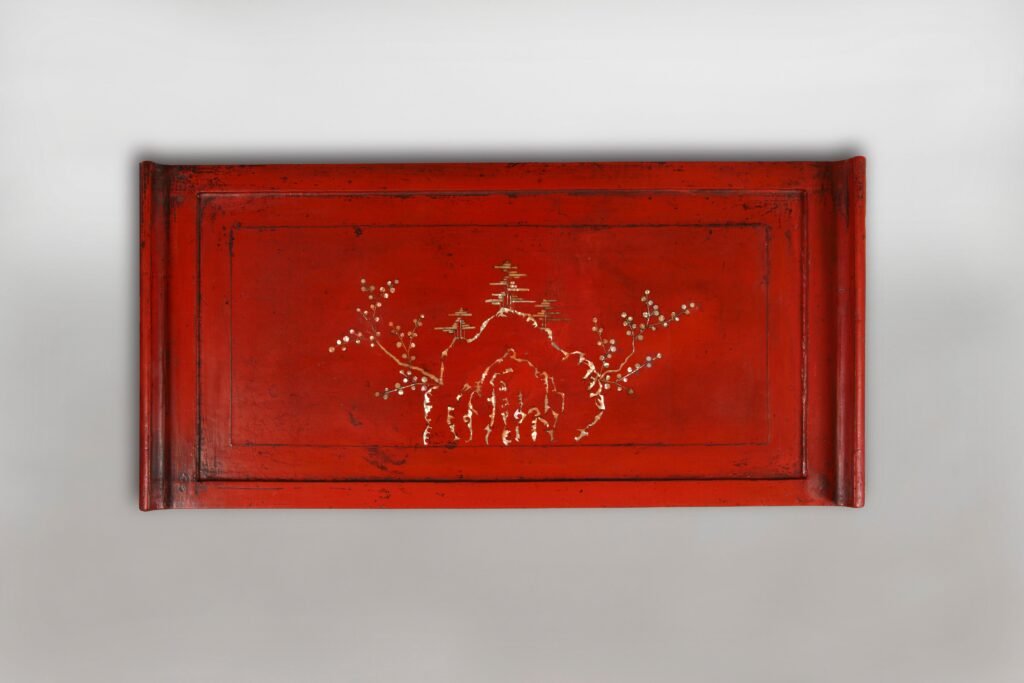
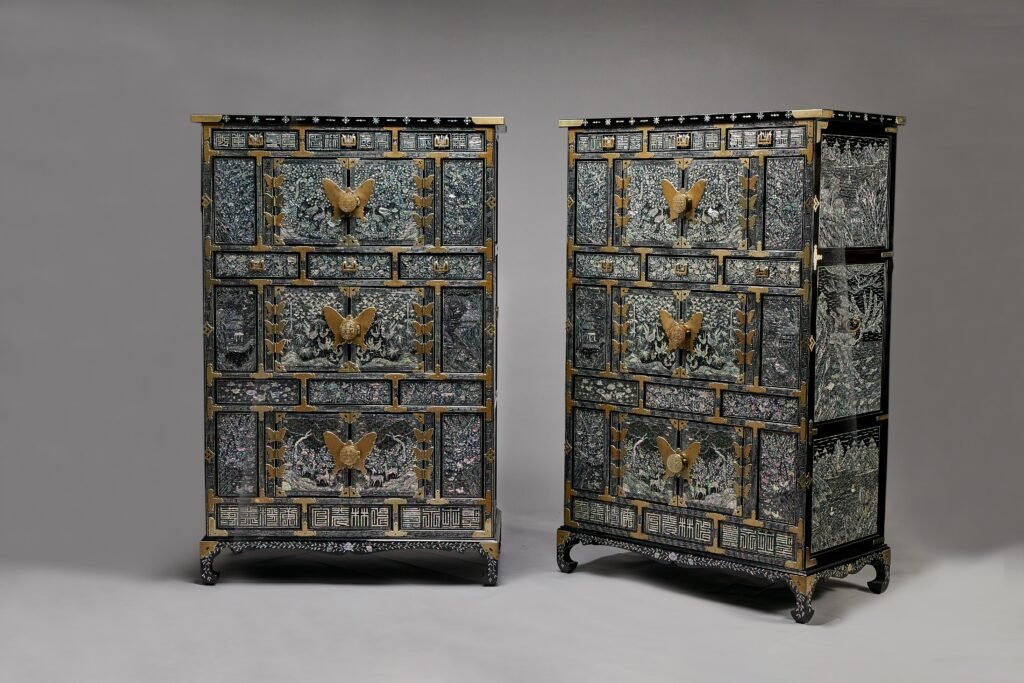
H. 151cm, W. 99cm, D. 49cm.
Collection: Namgaram Museum, Jinju city, Gyeongsang Do province.
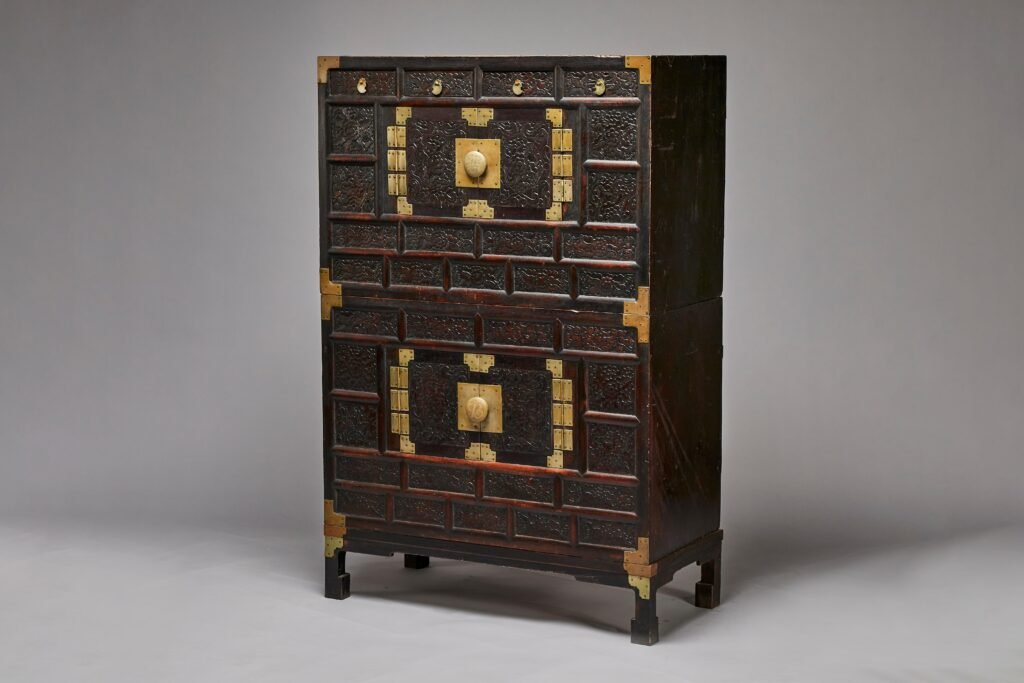
H. 124cm, W. 83cm, D. 39cm.
Collection: NAMGARAM MUSEUM. Jinju-si, Gyeongsangnam-do
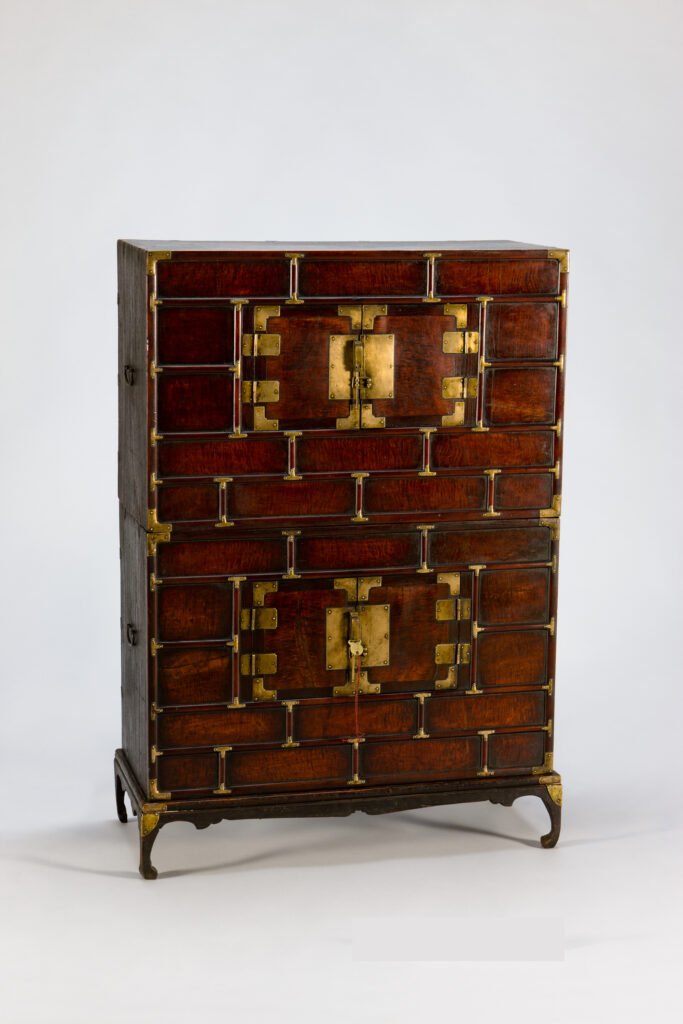
H. 127,5cm, L. 41cm, W. 90cm.
Two-tiered Clothing Chest
Two-tiered cabinets like this were generally used to store clothing, fabric, or raw cotton, in the anbang, the room used by the female head of a family. There are two main types of Joseon cabinets. The first type has full-length vertical side panels, so that the tiers are inseparable. This cabinet is the second type, having separable tiers that are stacked atop one another, with handles on the side of each tier, allowing them to be easily detached and moved.
Information provided by the National Museum of Korea where this chest is coming from.

